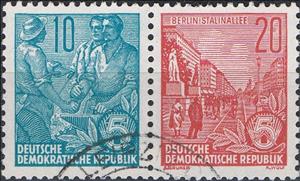Se-tenant: 3 Workers,Berlin Stallin Avenue (Germany, Democratic Republic 1955)
3 Workers,Berlin Stallin Avenue (Germany, Democratic Republic 1955)
01 March (Germany, Democratic Republic ) within release Five-year Plan goes into circulation Se-tenant 3 Workers,Berlin Stallin Avenue face value 30 East German pfennig
| Se-tenant 3 Workers,Berlin Stallin Avenue in catalogues | |
|---|---|
| Michel: | Mi: DD W5 |
Se-tenant is square format.
Also in the issue Five-year Plan:
- Se-tenant - Berlin Stalin-Avenue face value 2*20;
- Se-tenant - Woman at the steering wheel,Berlin Stallin-Avenue face value 25;
- Se-tenant - 3 Workers face value 2*10;
- Booklet - Woman at the steering wheel,3 Workers,Berlin Stallin-Avenue face value 2;
- Se-tenant - 3 Workers,Woman at the steering wheel face value 15;
- Se-tenant - Berlin Stallin-Avenue,Woman at the steering wheel face value 25;
- Se-tenant - 3 Workers,Berlin Stallin Avenue face value 30;
- Se-tenant - 3 Workers,Woman at the steering wheel face value 15;
- Se-tenant - Berlin Stallin-Avenue,Woman at the steering wheel face value 25;
- Booklet Pane - Berlin Stallin-Avenue,Woman at the steering wheel face value 75;
- Se-tenant - Woman at the steering wheel,Berlin Stallin-Avenue face value 50;
- Booklet Pane - 3 Workers,Woman at the steering wheel face value 45;
- Se-tenant - Berlin Stallin Avenue face value 2*20;
- Se-tenant - Woman at the steering wheel face value 2*5;
- Se-tenant - Woman at the steering wheel,3 Workers face value 15;
- Se-tenant - 3 Workers face value 2*10;
- Se-tenant - Berlin Stallin-Avenue,3 Workers face value 60;
- Se-tenant - Woman at the steering wheel,3Workers face value 30;
- Booklet Pane - 3 Workers,Berlin Stallin-Avenue face value 25;
- Se-tenant - Berlin Stallin Avenue,3 Workers face value 30;
Se-tenant 3 Workers,Berlin Stallin Avenue it reflects the thematic directions:
Architecture (Latin architectura, from the Greek ἀρχιτέκτων arkhitekton "architect", from ἀρχι- "chief" and τέκτων "builder") is both the process and the product of planning, designing, and constructing buildings and other physical structures. Architectural works, in the material form of buildings, are often perceived as cultural symbols and as works of art. Historical civilizations are often identified with their surviving architectural achievements.
A building or edifice is a structure with a roof and walls standing more or less permanently in one place, such as a house or factory. Buildings come in a variety of sizes, shapes and functions, and have been adapted throughout history for a wide number of factors, from building materials available, to weather conditions, to land prices, ground conditions, specific uses and aesthetic reasons. Buildings serve several needs of society – primarily as shelter from weather, security, living space, privacy, to store belongings, and to comfortably live and work. A building as a shelter represents a physical division of the human habitat (a place of comfort and safety) and the outside (a place that at times may be harsh and harmful).
A craft or trade is a pastime or an occupation that requires particular skills and knowledge of skilled work. In a historical sense, particularly the Middle Ages and earlier, the term is usually applied to people occupied in small scale production of goods, or their maintenance, for example by tinkers. The traditional term craftsman is nowadays often replaced by artisan and by craftsperson.
A monument is a type of structure that was explicitly created to commemorate a person or event, or which has become relevant to a social group as a part of their remembrance of historic times or cultural heritage, due to its artistic, historical, political, technical or architectural importance. Examples of monuments include statues, (war) memorials, historical buildings, archaeological sites, and cultural assets. If there is a public interest in its preservation, a monument can for example be listed as a UNESCO World Heritage Site. The Palgrave Encyclopedia of Cultural Heritage and Conflict gives the next definition of monument:
A people is a plurality of persons considered as a whole, as is the case with an ethnic group or nation. Collectively, for example, the contemporary Frisians and Danes are two related Germanic peoples, while various Middle Eastern ethnic groups are often linguistically categorized as Semitic peoples.
A road is a thoroughfare for the conveyance of traffic that mostly has an improved surface for use by vehicles (motorized and non-motorized) and pedestrians. Unlike streets, whose primary function is to serve as public spaces, the main function of roads is transportation.






